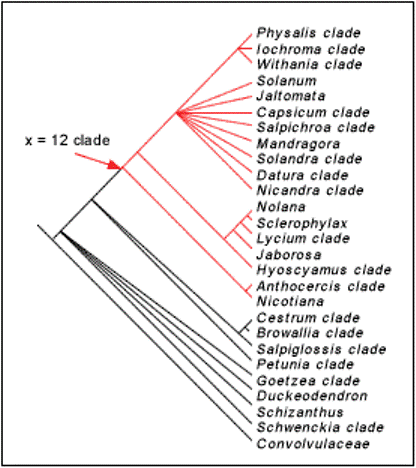Classification of the Potato
Solanum is the largest genus in the Solanaceae Family
with an estimated 1,400 species. It is also one of the
largest genera of flowering plants. Below are the
classifications of the potato, and two phylogenetic trees.
Domain: Eukarya – Organisms with membrane-bound organelles and a true nucleus.
Kingdom: Plantae – Plants
Phylum: Anthophyta – Flowering Plants
Subkingdom: Tracheobionta – Vascular plants
Superdivision: Spermatophyta – Seed plants
Division: Magnoliophyta – Flowering plants
Class: Magnoliopsida – Dicotyledons
Subclass: Asteridae
Order: Solanales
Family: Solanaceae – Potato family
Genus: Solanum – Nightshade
Species: Solanum tuberosum
Common names: Potato, Tater, Spud, Tuber

This is a framework phylogeny of the family Solanaceae. It is based upon
molecular data of both chloroplast and nuclear DNA. The red pointer
indicates a strongly supported
monophyletic group.

This is a schematic phyogenetic tree of the genera of Solanum.
To see the different species of each genera, click
HERE.
This tree is based upon molecular data from chloroplast ndhF. It
identifies 13 subgenera in the Solanum genus.
Check out the Interesting Facts
page to learn about the lighter side of potatoes!
A special thanks to the Natural History Museum for letting me use the tables,
and to the 10 references below who worked on it. Visit
here for more information about the phylogeny of potatoes.
References:
Bohs, L. (2005) Major clades in Solanum based in
ndhF sequences. Pp. 27-49 in R. C. Keating, V. C.
Hollowell, & T. B. Croat (eds.), A festschrift for
William G. D’Arcy: the legacy of a taxonomist.
Monographs in Systematic Botany from the Missouri
Botanical Garden, Vol. 104. Missouri Botanical
Garden Press, St. Louis.
D’Arcy, W. G. (1979) The classification of the
Solanaceae. J. G. Hawkes, R. N. Lester, and A. D.
Skelding (eds.), The biology and taxonomy of the
Solanaceae. Academic Press, London. Pages 3-47
D’Arcy, W. G. (1972) Solanaceae studies II:
typification of subdivisions of Solanum. Ann.
Missouri Bot. Gard. 59: 262-278
D’Arcy, W. G. (1991) The Solanaceae since 1976,
with a review of its biogeography. Pages 75-137 in:
J. G. Hawkes, R. N. Lester, M. Nee, and N. Estrada
(eds.), Solanaceae III: taxonomy, chemistry,
evolution. Royal Botanic Gardens, Kew, U.K. Pages
75-137
Fay, M. F., R. G. Olmstead, J. E. Richardson, E.
Santiago, G. T. Prance, and M. W. Chase (1998)
Molecular data support the inclusion of
Duckeodendron cestroides in Solanaceae. Kew
Bulletin 53: 203-212
Hunziker, A. T. (1979) South American Solanaceae: a
synoptic survey. J.G. Hawkes, R. N. Lester, and A.
D. Skelding (eds.), The biology and taxonomy of the
Solanaceae. Academic Press, London.
Hunziker, A. T. (2001) Genera Solanacearum. A. R.
G. Ganter, Ruggell. Pages 49-85.
Olmstead, R. G. and J. D. Palmer (1992) A chloroplast
DNA phylogeny of the Solanaceae: subfamilial
relationships and character evolution. Ann. Missouri
Bot. Gard. 79:346-360
Olmstead, R. G., and J. A. Sweere (1994) Combining
data in phylogenetic systematics: an empirical
approach using three molecular data sets in the
Solanaceae. Systematic Biology 43:467-481
Olmstead, R. G., J. A. Sweere, R. E. Spangler, L.
Bohs, and J. D. Palmer (1999) Phylogeny and
provisional classification of the Solanaceae based
on chloroplast DNA. M. Nee, D. E. Symon, R. N.
Lester, & J. P. Jessop (eds.), Solanaceae IV:
advances in biology and utilization. Royal Botanic
Gardens, Kew, U.K. Pages 111-137
|